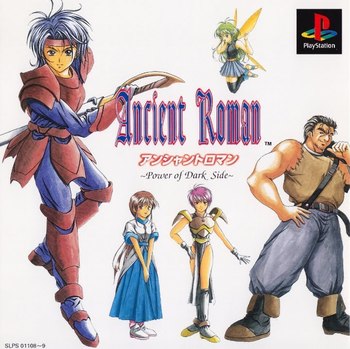
Released on April 23, 1998 by Nihon Systems in Japan only, Ancient Roman: Power of Dark Side is a seemingly-standard turn-based RPG in a fantasy setting. However, the thing that best sets it apart from the others is its poor production values, particularly its sound and remarkably-well-aged 3D graphics.
The game revolves around The Hero, Kai Orfeasnote , who was kidnapped out of his mother's hands as a child by a monster. He is sent to work in the mines until he works his way to freedom at 17. With the help of his friends Michelia Almeyernote and Burke Schwartz note , he finally wants to explore the world outside of the town he has worked his entire life in, to discover his true origins. Shortly after, he finds the ruins of a fortress and a town, and he discovers that a virus is turning the world's inhabitants into monsters. Other playable characters in this journey include:
- Fara Misuchirunote : Fairy
- Mina Erno Roanote : Elf
- McLeod Eschernote : Mercenary
- Serena Genatosnote : Swordfighter
- Baroa Kitenote : Sailor
This game examples of:
- Amazing Technicolor Battlefield: Completely subverted. The cutscene before the final boss implies that the fight should very well take place on an Amazing Technicolor Battlefield, but the actual battle takes place in the same, empty, detail-lacking room made of bright yellow brick as the previous battle.
- Combat Hand Fan: One of the enemies toward the end of Disc 1 fights with a fan, though it's slightly hard to make out.
- Death Throws: Upon defeat, characters are flung to the corner of the screen, accompanied by the damage number of the attack that killed them. This applies not just to common mooks, but even to the final boss and player characters.
- Disc-One Final Dungeon:
- The most straight-forward version of this trope appears when Kai climbs a tower when he returns to his hometown, which is also the last dungeon, and contains the last boss, of the game's first disc..
- A more convincing example are the two towers right before the final boss, as the music, aside from the docks, is ominous, including a new song that is introduced in one of the dungeons. This is also after a MacGuffin hunt that has been going on throughout most of the second disc.
- Duel Boss: Each character in the second disc must fight the God aligned to them one-on-one to each get their respective Ultimate Weapon and advance the plot..
- Heroes Prefer Swords: The protagonist, Kai, fights with a sword, along with several other party members.
- Hidden Elf Village: This game's circus-like elf village really shows how much the developers put into some of their pre-rendered areas. The sky is pitch black, the town is situated on a completely flat circle, the area is composed of a lot of contrasting reds, blues, yellows, browns, and pinks, and all of the surfaces are round, smooth, and shiny.
- Hot Springs Episode: One of the early-game towns has a hot springs, which unlocks a bonus cutscene involving the hot springs after the end of the game.
- Inn Security: Discussed in the game, and later averted. The party stays at an inn in an abandoned town, and they ultimately decide on Burke staying in front of the door and while Kai and Michelia sleep. While Burke notices a sound in the room, it is just a dying person about to be turned into a monster, and asked to be put out of his misery.
- Level-Locked Loot: Each character must be at least a certain level in order to use certain spells.
- Minimalistic Cover Art: Downplayed, as it still features art of five of the playable charactersnote , but the background is still just white.
- Never Trust a Title: There seems to be no Ancient Romans or Ancient Rome in the entire game, despite it being part of the title. But very much, this could all be lost in translation.
- Summon Magic: One of the game's higher-level magic spells summons a Chariot that runs over all the enemies.
- Sword of Plot Advancement: Each party member on the second disc has their own weapon, considered their ultimate weapon, that is needed to complete the game. To get each one, each character must first fight the God that is aligned to them one-on-one..
- The Virus: One of the antagonizing forces in the game is when the party finds out that a virus is turning people into monsters. This is first revealed when the party chooses to rest at the abandoned town toward the beginning of the game, when they find someone who is dying and is revealed to be turning into a monster.
- Vehicular Theme Naming: most elemental spells are all named after cars, including Toyota and Porsche.
